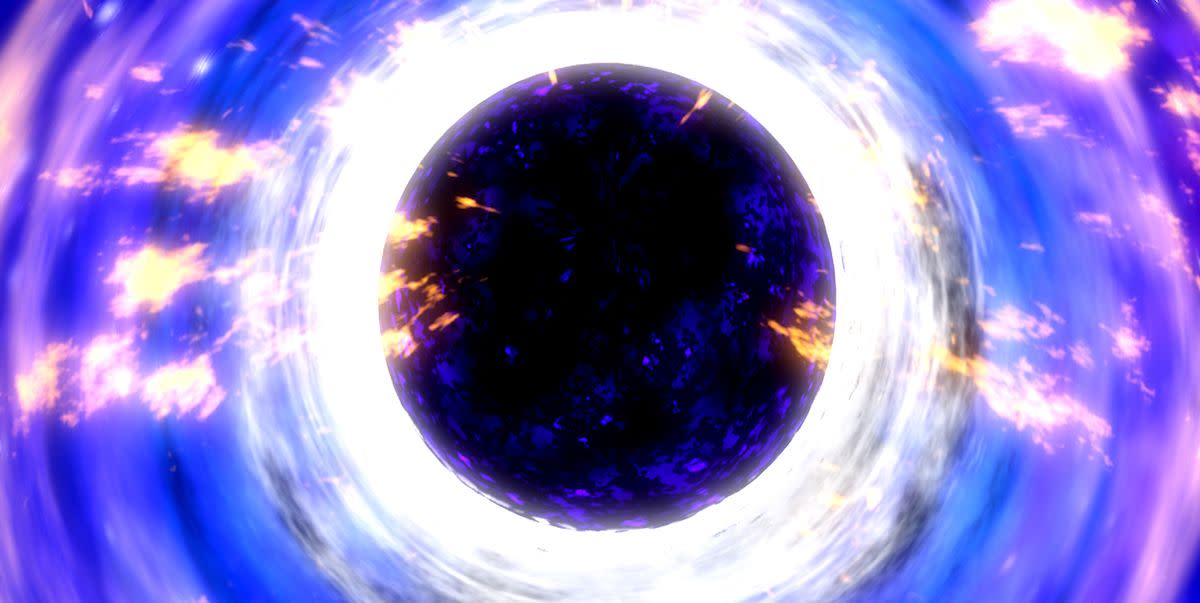If Planet 9 Is Actually a Black Hole, It Completely Changes How We Understand Our Universe

A team of theoretical physicists have proposed that the mysterious planet thought to orbit the sun at the edge of the solar system may actually be a primordial black hole.
Primordial black holes don’t form from stellar collapse. Instead, they're ancient remnants of the formation of the universe.
Bursts of gamma rays may be the key to identifying whether this primordial black hole exists.
Strange things are happening at the edge of our solar system. A number of large rocky bodies, mostly asteroids and comets in the Kuiper Belt, are hurtling along an odd orbit perpendicular to most of the orbits in the solar system.
“There’s very likely something maintaining them on these orbits,” theoretical physicist Jakub Scholtz, of Durham University, tells Popular Mechanics. That something could be a black hole.
Astronomers have long pondered the existence of a mysterious ninth planet, which orbits the sun far beyond Neptune and Pluto. In 2016, Mike Brown (who demoted Pluto) and Konstantin Batygin rattled the scientific community when they published their groundbreaking paper, which proposed the existence of a planetary body in the outer reaches of the solar system.
But a radical new theory suggests it may not be a planet after all. Instead, it could be an ancient primordial black hole that could fit inside the palm of your hands, according to a new study.
“Primordial black holes typically form in the very early universe, since they're typically due to over densities in the primordial distribution of matter,” theoretical physicist James Unwin, of the University of Illinois at Chicago, tells Popular Mechanics. Unwin and Scholtz coauthored the study, which was recently published to the preprint server arXiv.
We’ve so far only caught glimpses of three types of black holes: stellar-mass black holes, intermediate-mass black holes, and supermassive black holes, like the one at the center of galaxy M87, according to Astronomy. Many primordial black holes with extremely small masses are thought to have evaporated shortly after the big bang.
Even though there haven’t been direct observations, the evidence that something at the edge of the solar system exists is compelling. In addition to the perplexing orbital shifts of the Kuiper Belt objects, scientists are turning to a phenomenon called microlensing to help explain their theory.
Astronomers sometimes point their telescopes toward large clusters of stars, like in the middle of the Milky Way. Objects that pass in front of those stars can distort our view of them, causing them to flash. “If [the passing object] is massive enough and passes close enough in front of one of these stars, it would actually bend the light and slightly change the brightness of the star,” says Scholtz.
Other objects that pass in front of the star, such as brown and white dwarfs, can also cause these brief changes in brightness, so scientists have to analyze the duration of the flash to pinpoint the culprit. This “corresponds to objects that have way too low of a mass,” says Scholtz. Like, say, a primordial black hole.
If this mystery planet—made of regular matter—does exist, astronomers believe it would take between 10,000 and 20,000 Earth years to orbit the sun at a distance of between 300 and 1000 AU, according to NASA. It would also likely have a mass between five and 15 times that of Earth, and would be approximately the size of Neptune.

If the mystery object were a primordial black hole, however, it would be far smaller. Unwin and Scholtz propose that this five-times-Earth-mass primordial black hole could have a radius of roughly five centimeters—about the size of an orange. A primordial black hole 10 times the mass of Earth would be roughly the size of a bowling ball.
If the scientists are right, detecting a primordial black hole this size would prove to be an immense challenge. Still, the team aims to dig through recent data from the Fermi Gamma-ray Space Telescope. They hope to spot spot potential bursts of gamma rays brought on by interactions between the dark matter and dark antimatter surrounding the hypothetical primordial black hole.
But what does all this mean for Earth?
In short, rest easy. It wouldn’t threaten life as we know it. “From this distance, the black hole acts, gravitationally, just as a planet would,” says Scholtz. “It has zero influence on Earth.”
Instead, it could actually help solve some of life’s greatest mysteries. Primordial black holes witnessed the creation of some of the universe’s most mysterious particles. For instance, theory calculation suggests that primordial black holes would have been created at a time when the universe was just the right temperature to be sensitive to the Higgs Boson physics, Scholtz says.
“We don't understand the connection between general relativity and quantum mechanics, and a tiny black hole is an excellent place to go think about these things,” says Unwin. If their hypothetical black hole exists, and it’s something we can visit, it could revolutionize our understanding of the universe.
There could even be some practical benefits to having our own neighborhood primordial black hole. "We have a lot of problematic nuclear waste, and that's a good place to dump it," jokes Unwin. (Both Scholtz and Unwin admit that launching nuclear waste out of Earth's atmosphere poses problems of its own.) “Maybe not the best plan, but it’s a fun thought,” says Scholtz.
Ultimately, they argue, they’re simply promoting an open mind. “By saying it's a planet and looking for it as if it's a planet, you're limiting the tools you use to actually search for this thing,” says Unwin.
You Might Also Like

